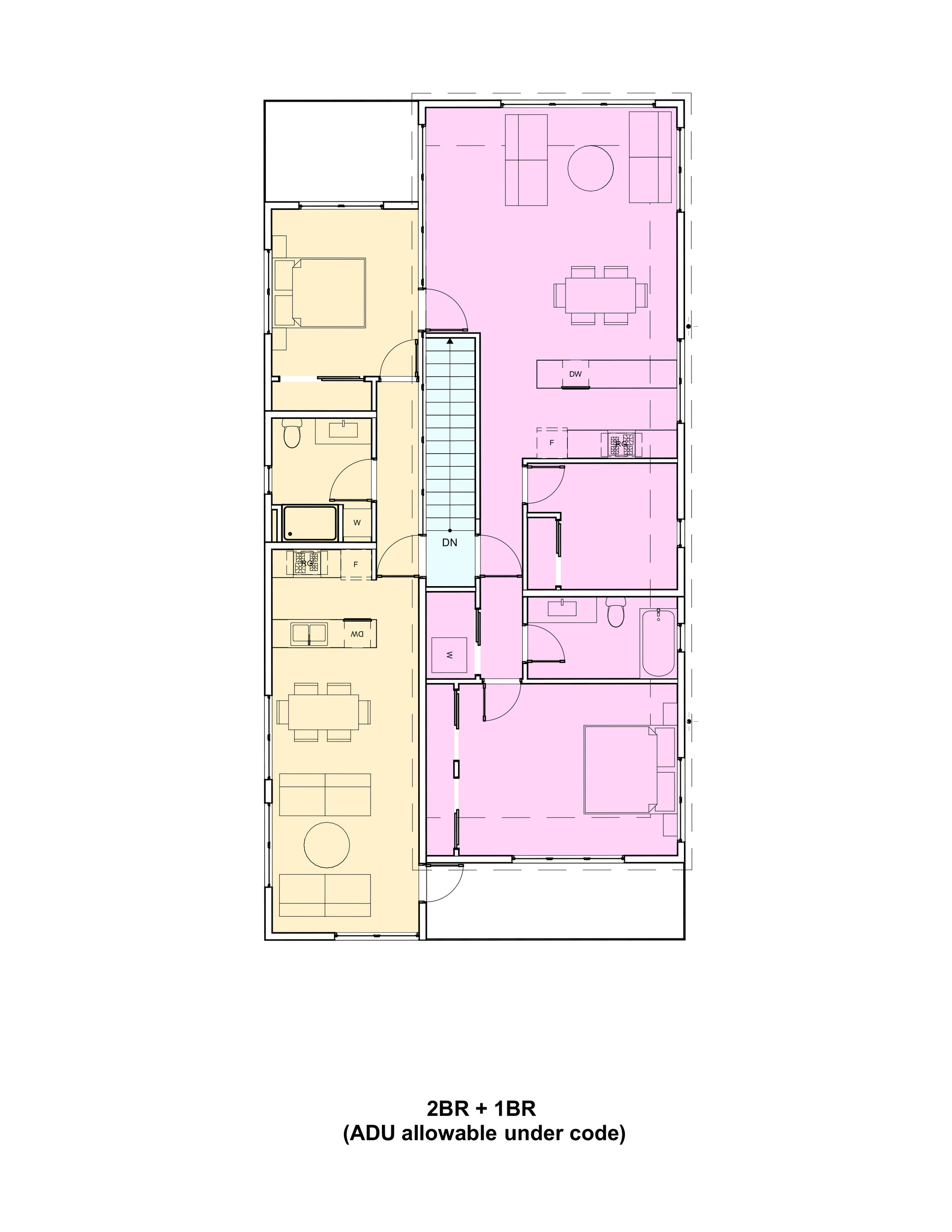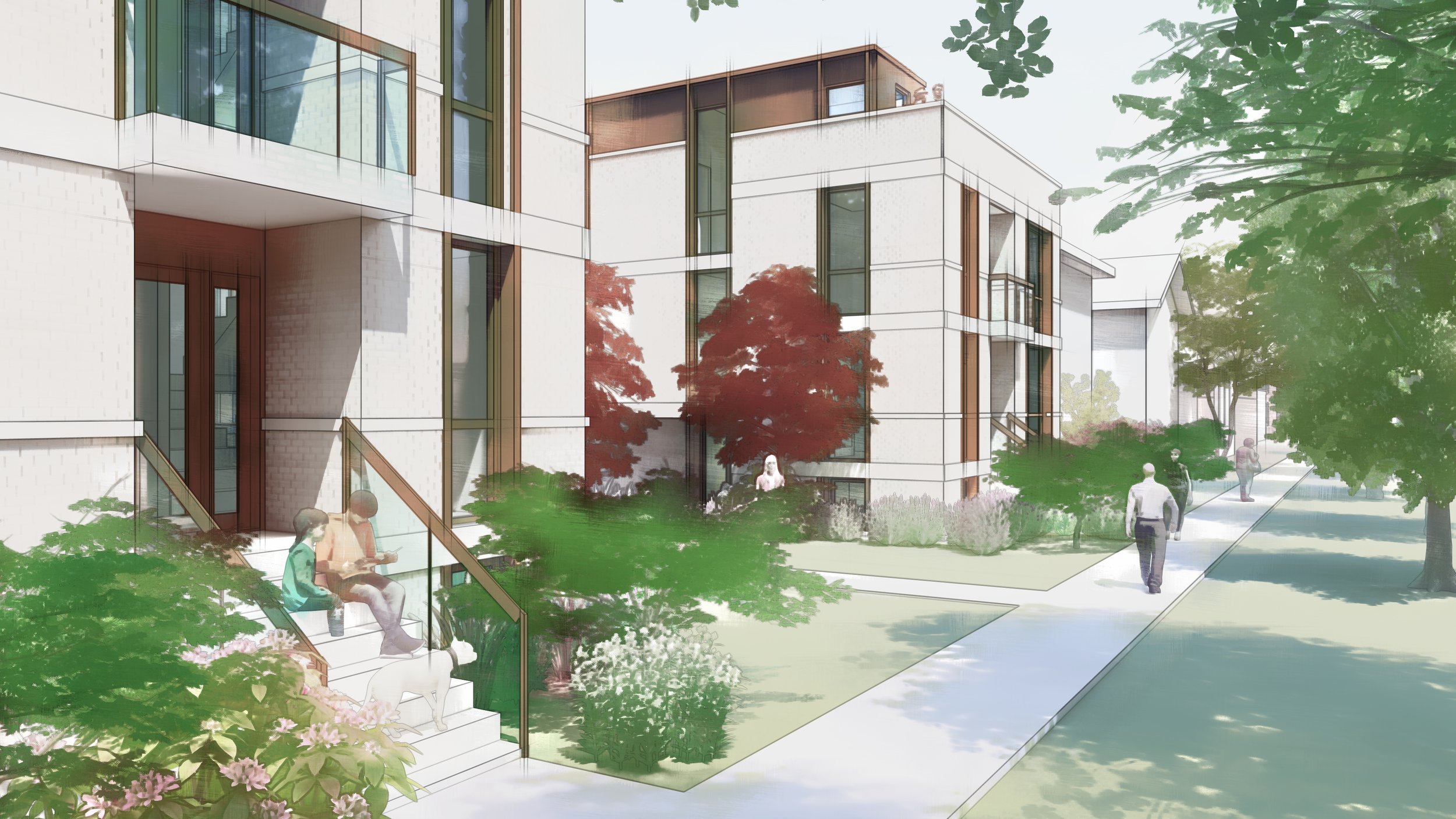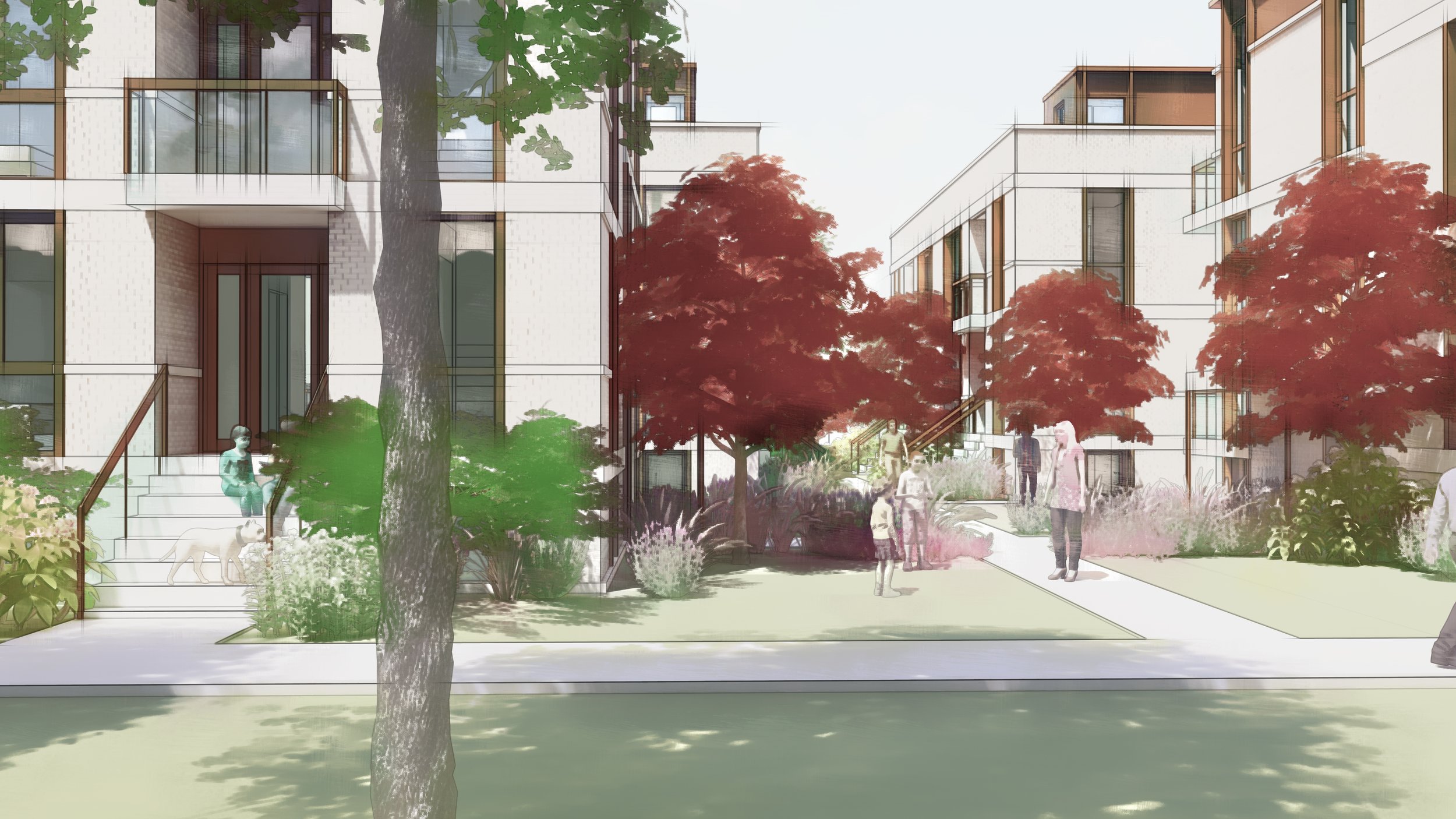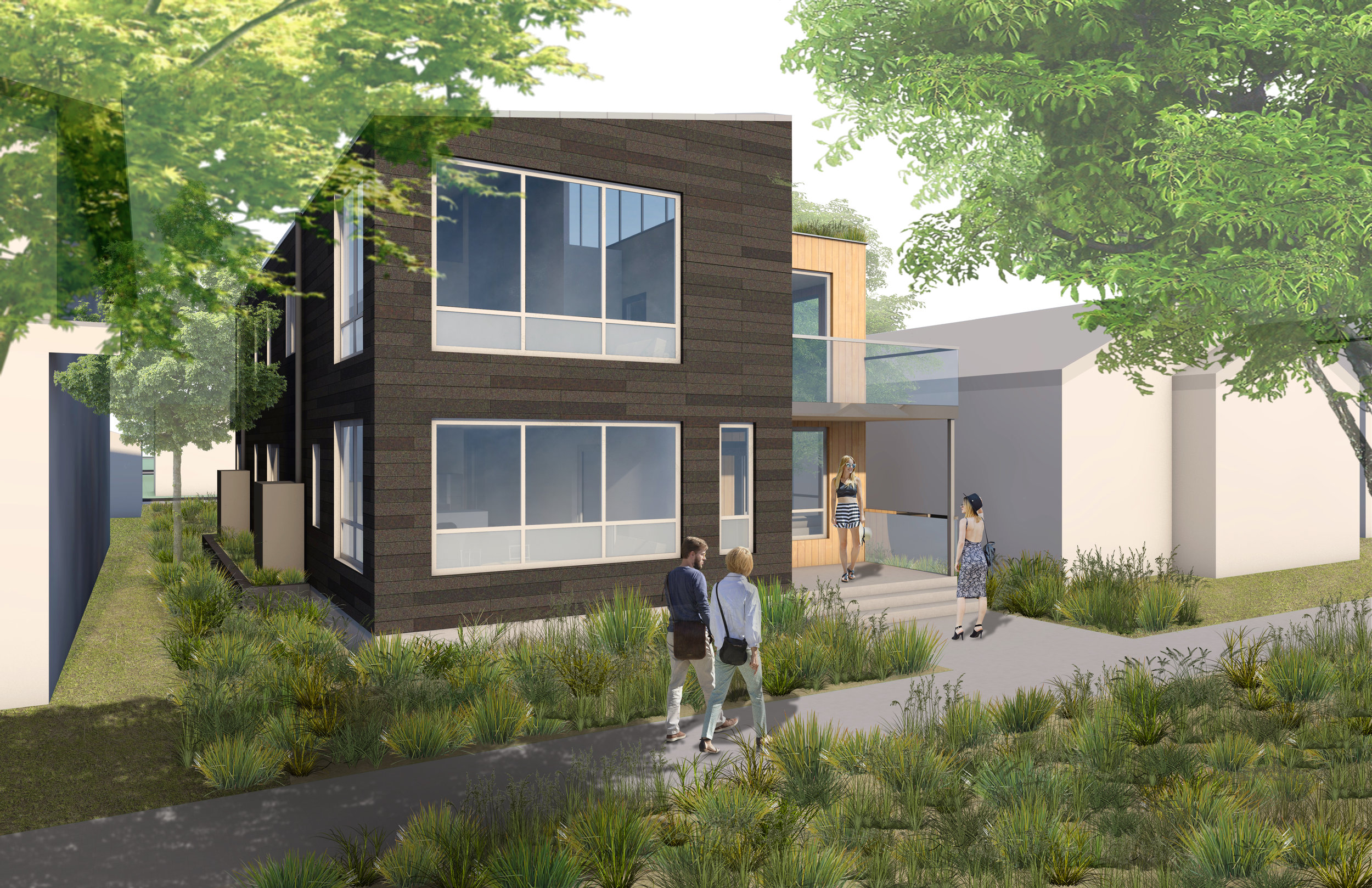Download it here: New Housing Options in Residential Small Lot (RSL) zone.
Residential Small Lot will allow little stacked flats like this. How you use them is up to you!
If you are thinking about downsizing but don’t want to relocate to a new neighborhood, or to a tiny impersonal apartment in a big boxy building, there are very few choices out there.
Luckily, with Seattle’s Residential Small Lot Zoning (RSL), there are some fresh options. CAST architecture has been working with the land use code for about a year, and now that it is approved in many Seattle Urban Villages and Hubs like Crown Hill, West Seattle, Morgan Junction, and Roosevelt, we want to show off some of the possibilities to do density right!
We often lament that there are essentially very few single level living situations that aren’t little condos, and even fewer that have been built this century.
With this ‘Double Up’ Duplex, there are two primary residences, one at ground level, one up. Each primary residence can be configured with an Accessory Dwelling unit. At 2200 square feet per level Including the ADU), that could be a generous home with a built in rental stream. If someone wanted to develop the whole building, it would be perfectly legal to own the entire building, rent one level, and the ADU adjacent. Don’t want to be a landlord? It can be configured as a condo association.
Downsized, accessible, modern, super energy efficient living, with two revenue streams, not to mention a great front porch and big backyard!
On any RSL lot, we can design a two unit flat with accessory dwellings units.
Here is a second story plan, with a primary and accessory unit. could easily be a 3br and studio apartment
We’re excited about what is possible under Residential Small Lot and hope that the best solutions get adopted far and wide!
Residential Small Lot zoning will create new housing options in established urban village neighborhoods
Mandatory Housing Affordability passed City Council yesterday, and as part of that, about 7000 urban Single Family lots will now be able to have two or three primary residences (plus ADUs) on site. I’m pleased that we were able to suggest some amendments that will make the zone more workable, improve flexibility for sites where people would like to preserve the original house.
What is RSL?
In a nutshell:
1 primary residence per 2000 sq ft of lot (one ADU per primary residence allowed)
if your lot is smaller than 4000 sq ft, you could still do two residences.
Floor Area Ratio : .75
Lot coverage: 50%
Maximum size of any single primary residence: 2200sq ft.
Residential Small Lot Streetscape
While conceived as a kind of new ‘cottage’ zoning, it is better suited to compact 2 1/2 story urban houses.
We’ve come up with a prototypical design which maxes out all the limits, and it still feels pretty good within the existing streetscape. It is a 1500 sq ft upper unit, with main level suite, and open living/dining/kitchen (w/ twelve foot ceilings), two typical bedrooms and a second master on level two, with a patio/kitchen garden on the roof. In the basement (half below grade to avoid being counted toward F.A.R.) we’ve designed a 1 bedroom/1 bath Accessory Dwelling Unit, which could easily be integrated into the primary house, set up to generate revenue to help with the mortgage, or be co-owned like a two party condo association.
Because it is a relatively compact volume, with flexibility about solar orientation for a range of urban sites, hopefully we’ll get some owners interested in pursuing Passive House green building standards!
Residential Small Lot zoning: Courtyard bungalows
There is a real opportunity, once you start combining lots, to also aggregate the open space, and get back to that Courtyard Bungalow type that we used to build before zoning made them by and large illegal. Since parking isn’t going to be required for most, the market is going to dictate, but hopefully we’ll be spared a lot of impervious area creating more run off issues.
What is the RSL market and will any of it be affordable?
While I’m pretty excited about the eventual potential of this zone, there are very few neighborhoods where this is going to pencil (i.e. high priced, high demand markets).
1) it is happening where land values are going to be the highest (urban villages), but with the low density limits, land costs cannot be spread across more than 2 or 3 units for the most part—at minimum $300K of any newly developed unit is going to be for land value.
2) With low densities, it will be nearly impossible to provide new rent restricted housing on site. Nearly all development will pay the MHA fee (up to $45,650 per unit). With the ‘downzones’ to RSL that Council enacted with the late amendments taking many Lowrise areas a step back, it ensures than most of those areas will never see rent-restricted housing.
3) Similar to Vancouver’s market where the high cost of detached housing is tempered by ‘mortgage helpers’ like Laneway houses, ADUs are really the only new less expensive option, and that is purely because of the size of those units.
Seattle is going to change thousands of residential lots from ‘Single Family’ to ‘Residential Small Lot’ (RSL) as part of the MHA zoning reform. The rules covering RSL have been totally rewritten and there are many questions about how it will affect our neighborhoods such as Crown Hill, West Seattle, and South Park
First, what is RSL and what kinds of new development are we likely to see?
Second, how does RSL address displacement, affordability, density or sustainability?
If you live in one of the affected urban village or are interested in innovative infill housing, join Matt Hutchins, AIA for this informational talk.
RSVP here:
6 Courtyard townhouses on a 12,000 sf ft lot
Seattle is going to change thousands of residential lots from ‘Single Family’ to ‘Residential Small Lot’ (RSL) as part of the MHA zoning reform. The rules covering RSL have been totally rewritten and there are many questions about how it will affect our neighborhoods such as Crown Hill, West Seattle, and South Park
What is RSL?
Where is RSL?
What are the rules governing the density, size, etc?
How is MHA going to factor into development?
What is the difference between a backyard cottage and a second house?
What are some of the prototypical developments that are possible under the new code?
If you live in one of the affected urban village or are interested in innovative infill housing, join Matt Hutchins, AIA for this informational talk.
RSVP here:
RSLZ will allow courtyard walk-ups!
Seattle is going to change thousands of residential lots from ‘Single Family’ to ‘Residential Small Lot’ (RSL) as part of the MHA zoning reform. The rules covering RSL have been totally rewritten and there are many questions about how it will affect our neighborhoods such as Columbia City and Rainier Beach.
First, what is RSL and what kinds of new development are we likely to see?
Second, how does RSL address displacement, affordability, density or sustainability?
Finally, how can we improve RSL so that it can be the most effective before the ordinance comes before Council?
If you live in an urban village or are interested in innovative infill housing, join Matt Hutchins, AIA for this informational talk.
RSVP here:
https://www.eventbrite.com/e/envisioning-seattles-small-lot-zoning-future-tickets-52921269943
Seattle is going to change thousands of residential lots from ‘Single Family’ to ‘Residential Small Lot’ (RSL) as part of the MHA zoning reform. The rules covering RSL have been totally rewritten and there are many questions about how it will affect our neighborhoods such as Columbia City and Rainier Beach.
First, what is RSL and what kinds of new development are we likely to see?
Second, how does RSL address displacement, affordability, density or sustainability?
Finally, how can we improve RSL so that it can be the most effective before the ordinance comes before Council?
If you live in an urban village or are interested in innovative infill housing, join Matt Hutchins, AIA for this informational talk.
RSVP here:
https://www.eventbrite.com/e/envisioning-seattles-residential-small-lot-future-tickets-52921293012
Steelaway Cottage is finished! Clad in weathering steel, don’t let the tough exterior fool you! It is a very ‘hygge’ —Danish for that ‘cozy’, clean, well lit style— inside. At 800 square feet, it has still has 2 bedrooms, 2 baths, but it is snug as you might expect.
Seattle is going to change thousands of residential lots from ‘Single Family’ to ‘Residential Small Lot’ (RSL) as part of the MHA zoning reform. The rules covering RSL have been totally rewritten and there are many questions about how it will affect our neighborhoods, including most of South Park.
First, what is RSL and what kinds of new development are we likely to see?
Second, how does RSL address displacement, affordability, density or sustainability?
Finally, how can we improve RSL so that it can be the most effective before the ordinance comes before Council?
If you live in an urban village or are interested in innovative infill housing, join Matt Hutchins, AIA for this informational talk: Follow the link below to RSVP. Thanks!
https://www.eventbrite.com/e/envisioning-seattles-residential-small-lot-future-tickets-51155568683
Steelaway Cottage, by CAST architecture 2018
To celebrate the final Environmental Impact Statement that came out last week, we’d like to highlight some of the less obvious but clear reasons for progressive Seattle to embrace the new ordinance covering Accessory Dwellings.
1. Many ADUs end up being affordable, even if they are admittedly expensive to build. I have made the case over and over that we should approach ADUs with our eyes open as to the cost and not put too much faith in them as a cure-all for our housing crisis. But, in surveys collected from Vancouver, Portland, Ashland, Eugene, Edmonton, the Bay Area, a large percentage (generally around 20-25%) of accessory dwellings end up being rented for nothing, very little or well below market rate. Voluntary affordability, where the owner has prioritized the benefit of having family, friends, or even good tenants as neighbors over the potential rent they could demand if they were more ruthless landlords is a major benefit of this form of housing.
Voluntary Affordability in Portland. https://accessorydwellings.org/2014/08/07/do-adus-provide-affordable-housing/
Voluntary Affordability in Edmonton. https://accessorydwellings.org/2017/09/08/garden-suites-in-edmonton-a-private-investment-in-the-public-good/
For example, I have friends who have not raised the rent in 9 years for their upstairs mother-in-law apartment because they love the tenant but she’s on a fixed income. It’s a sweetheart deal they want to last as long as she can handle the stairs. These anecdotes are the rule for homeowners who’ve ‘DIY’ developed an extra unit on their property.
In Portland among owners who live in their ADU, 41% of the primary residences where offered for FREE. Meanwhile, we’re fighting tooth and nail over an inclusionary zoning program that might create 6–10% of new housing as rent restricted. The reality is that a naturally occurring housing type people desperately want to build all over is also 2 1/2 times more likely to create truly affordable housing than our best big policy idea.
2) Making Mother-in-Laws and cottages pencil financially counters wild speculation on McMansions. In the Draft EIS, the City ran different financial models for potential development outcomes. In the draft EIS, 46% of the possible scenarios resulted in tear down/replacement McMansions being the most profitable investment. It was only in cases where the land value was high and the lots were large that adding an ADU and DADU made sense. But if you value the neighborhood and want to curb the momentum of displacement and gentrification, supporting options where a second or third household can add rental income suddenly flips the proforma against the disruptive scourge of McMansions.
3) Renters are Seattle’s majority and any related stigma is out of touch. Owner occupancy restrictions are the biggest impediment to the creation of more housing and keep lower income renters out by limiting the number of options for less expensive dwellings to exist. The checkered history of zoning as a substitute for outlawed racial or class covenants is well documented.
More than 20% of Seattle houses are already rentals. We don’t have a restriction on renting out a detached house and has very few expectations of landlords (more might be in order) yet neighborhoods still thrive. Both tenant and landlord are by and large responsible neighbors. Ask any renter, and they will tell you that they are just as committed as property owners to the neighborhoods, support the local businesses, and participate in civic life. As the majority of Seattleites, renters make up the underlying tax base that funds our government, parks, police, and transit (renters pay property taxes too, just through rent).
4) Besides, owner occupancy restrictions should be illegal. Limiting WHO can use land, as opposed to what the land’s function is isn’t really the job of the land use code. Making property ownership the prerequisite to use is unique to ADUs and has been challenged elsewhere. Other jurisdictions, such as Alberta Canada explicitly allow residency without ownership wherever residences are allowed for that reason.
Find the duplex! (Answer below)
5) Finally, extra dwellings are already everywhere. While people might worry that allowing a ADU and a DADU without owner occupancy restrictions will lead to no less that the ‘destruction of our most unique resource, Seattle’s single family neighborhoods,’ the reality is that there is a long history of small multi-family dwelling coexisting with and even predating the now dominant paradigm of stand alone houses for solitary households. Turn of the last century neighborhoods, like Queen Anne and Wallingford (pictured above), valued for their amenities, walkability, and housing stock, were developed mostly before zoning. They are filled with the highest concentration of small multifamily buildings, house more than 10,000 households, but you might never know it from the street. Honestly that is part of their charm and vitality. If the worst thing is that there are a few more families per street, I think our neighborhoods are more than resilient enough to handle it.
Every dot is at least one extra household that doesn’t need a stand alone house.
*In the photo above every structure is a duplex, triplex or fourplex, with the exception of the tallest white structure on the left.


















